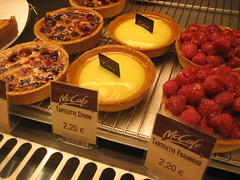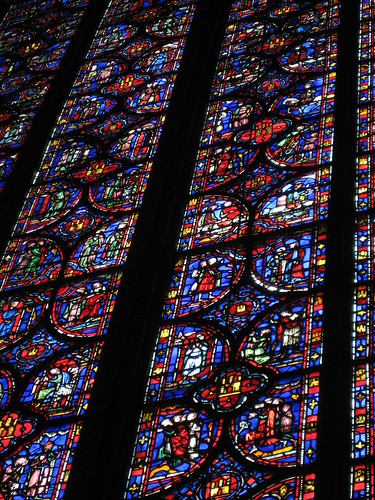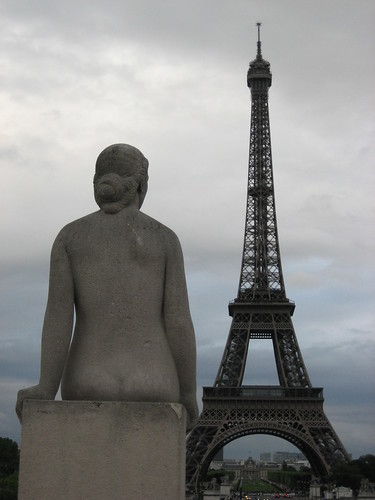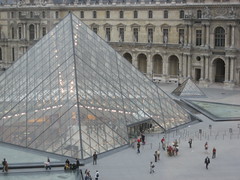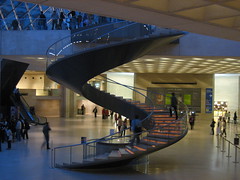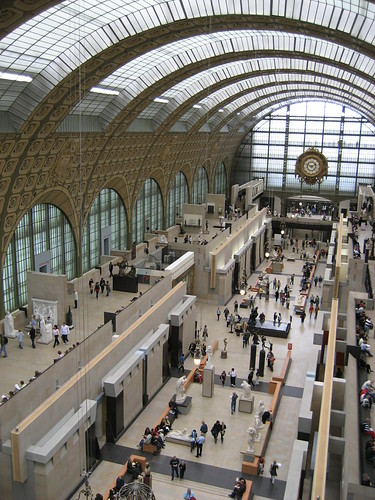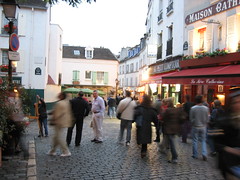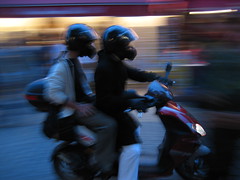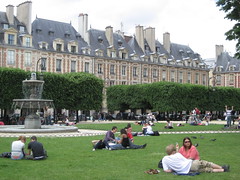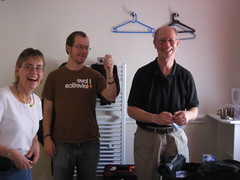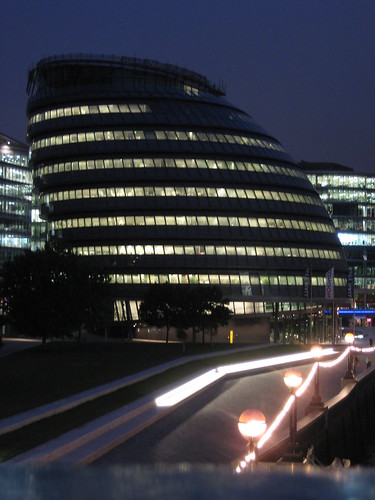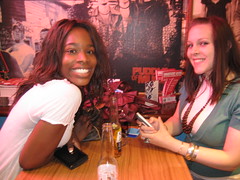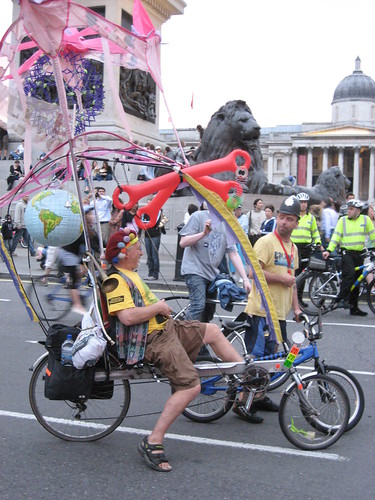Turkish Delight
I spent my last night in London curled up on the cold, hard floor of the Luton airport along with all the other backpackers and cheapskates with early-morning flights.
I arrived in Istanbul's outlying airport and took a shuttle bus across town, officially from Asia back to Europe. Istanbul's unique situation straddling two continents divided by the Bosphorous river, is a fitting symbol for the country of Turkey as a whole. The country has an odd set of neighbors, and sits sandwiched between the lesser-known countries of Eastern Europe, the western and mainland European influence of Greece, the troubled nature of the Middle East, and the independent spirit of the former USSR caucuses. Within the country itself, there is a huge and immediately noticeable divide between modernity and tradition, progressiveness and fundamentalism, secularism and spiritualism. The government of Turkey is being pulled by the Western parts of the country to modernize, reject Islamic fundamentalism, and push forward as a progressive nation in order to make a bid at joining the European Union. Those in central and eastern Turkey are more aligned with Turkey's history as a proudly Muslim state, and see the rapidly spreading culture of the west as an attack on their traditions and values. You've probably heard about the controversy around whether or not women should be allowed to wear head scarves in public institutions like universities. For now, wearing scarves is outlawed by the secular government, and the devout have responded with head scarves designed to look like popular Turkish hairstyles, which have apparently been enough of an effort to slip past the authorities.
One of my reasons for coming to Turkey was to see how a modern Muslim nation works — to see how the West might be able to adapt to Islam, and what it looks like when Islam adapts to the West.
I made it to the Sultanahmet neighborhood, where most travellers stay because of its close proximity to the big sights. Although certainly cheaper than London, Istanbul is not cheap, so I checked into the cheapest hostel I could find. For the first night, I had a 21-person room all to myself, which was a lucky break. The second night, however, a 20-person group of hyperactive 18-year-old New Zealanders showed up and turned the place into an instant party. And these kids took partying to a whole new level: In the course of 24 drunken hours, they had paraded through the streets nude, gotten into a fight, shot each other with fire extinguishers, broken a bed, gotten stoned, got attacked and bitten by dogs, started an outdoor pillow fight, and had gotten themselves arrested — twice. In the hostel room itself, alcohol flowed liberally, bottles were flying, smoke filled the air, and barely-clothed bodies swirled around the room without a care. And there I was, crotchety old Ryan Nee, in the midst of what looked like a crazy night on tour with Guns n' Roses. Here's a photo of my once-empty room, a few hours after they arrived:
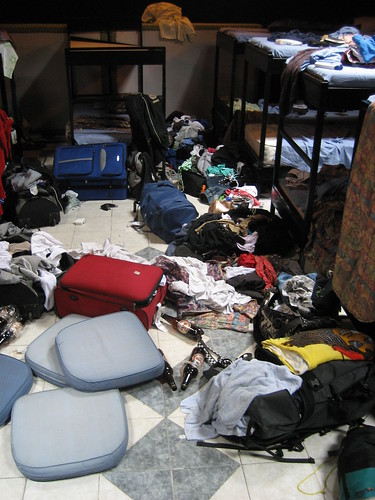
I wasn't feeling great about these traveler kids traipsing drunk around Istanbul, because I pictured the city being a pretty conservative place. I mean, Muslim people don't drink, right? As I quickly found out, the Muslims in western Turkey have pretty relaxed rules about what you can and can't do, and the young people in Istanbul love to party. Actually, Istanbul has some of the best nightlife I've seen yet.
One night, I headed out with Jackie and Sarah, a couple of American girls I met randomly on the street, who have spent the semester living in Istanbul on a study abroad program. We went out with a group of their friends to their favorite hangouts in the Taksim neighborhood, an area packed wall-to-wall with hundreds of bars and clubs, all packed with people drinking Efes Beer and raki, an awful black licorice-flavored local booze. At the end of the night — around 6:30 am — people poured out of the bars into the early morning sun and staggered over for some drunken grub to the awaiting kebab vendors lining the streets. Here's a photo of the crazy-crowded Taksim area and a shot of Jackie and Sarah during our bar-hopping spree:
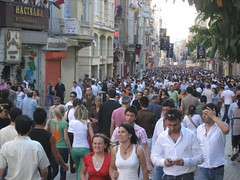
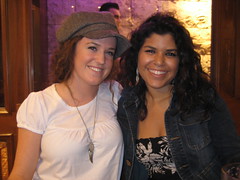
Drinking aside, I made it to some more cultural stuff as well. I visited the Grand Bazaar, which was full of 4000 shops aimed squarely at the tourist market. The covered bazaar is basically one of the world's first shopping malls, and I enjoyed walking through the historic alleys and checking out some of the overpriced antique shops. Ultimately, I found the neighborhood just outside the Grand Bazaar's walls to be infinitely more interesting, which was packed with local people buying everyday household items, spices, quick snacks, clothes, cheap electronics, and much more. The area made for phenomenal wandering and people-watching, and felt considerably more authentic than the Grand Bazaar itself.
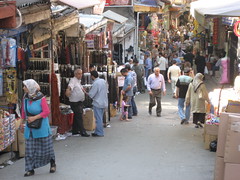
Dominating the Sultanahmet area are Istanbul's two most famous buildings: The Blue Mosque and the Hagia Sofia, which mirror each other across a pleasant park. I slipped into the Blue Mosque in between prayer time, and was awed by its massive size. Finished in 1616, the open and airy building is filled with the faintly turquoise tiles which give the mosque its name. The Blue Mosque is a about as perfect as buildings get.

And then I went across the park to the Hagia Sofia, and was completely blown away.
I've always wanted to see the Hagia Sofia in real life, and the building lived up to everything I hoped it would be. Completed in 537(!) as the focal point of the Roman Empire — then ruled from both Rome and Constantinople — the Hagia Sofia was built as a Christian church but was converted into a mosque about a thousand years later, well after the fall of the Roman Empire and when Islam reigned supreme in the area. The golden mosaics and holy images were stripped from the church, and were replaced by dark walls, patterned Islamic designs, and the giant circular pendants covered in Arabic script for which the Hagia Sofia is famous. A handful of the old Christian mosaics survived the 500 years the building was a mosque, and are on display at the building, now a museum. I couldn't get over how gigantic the building 1500 year old building was — look at the tiny people in this photo for a sense of scale, followed by an up-close look at one of the few surviving Christian mosaics:

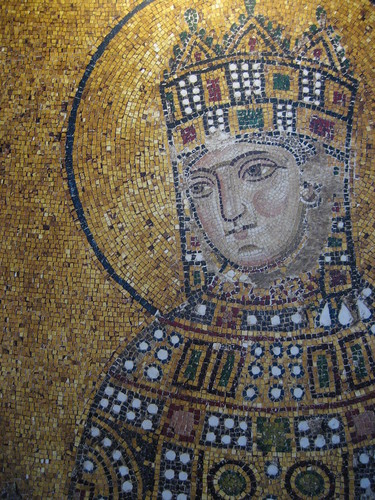
Another day brought me out across the river to an area with a lot of hip art galleries, botique shops, and musical instrument stores. Along the waterfront, hundreds of people lean along the Galata Bridge to try their luck at catching a fish from the river below. Meanwhile, the savory smell of cooking fish wafts up from the handful of restaurants nearby, attempting to lure the fishermen into packing up their poles and ending their fishing trip early.
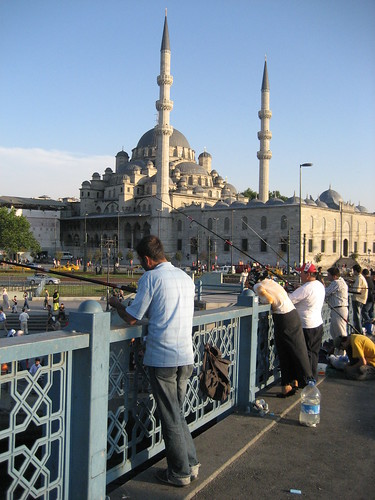
Since I would be returning to Istanbul later, I opted out of the other tourist must-sees for now and caught a night bus south to Selcuk. I had heard great things about Turkey's buses, but after trying them out, I find them to be a somewhat awkward experience. First, there's a bus attendant (or sometimes two) who comes around every few hours and offers tea, coffee, water, or Coke. To keep the bus smelling flowery, the attendant sprays excessive amounts of air freshener into the air, then comes around and pours lemon-scented water on each passenger's hands to help us freshen up. Every hour or so, the bus stops for a long bathroom break and the attendant and driver jump out in order to wash the bus and check on the engine. On overnight buses, this process repeats all night long. All of the fanfare is kind of fun, but it takes a painful amount of time to get anywhere as a result. My ten hour bus to Selcuk spent about six hours actually driving and the rest of the time dicking around or washing the bus.
I finally made it to Selcuk — after a crucial bus-wash 15 minutes outside of town — and settled into Atilla's Getaway, which is like a luxury(ish) resort for backpackers. I made friends with Emmanuelle from Quebec, Matt from Sydney, and Eli from Berkeley, with whom I spent the better part of a week splashing around in the pool, getting some epic R&R, wandering around Selcuk, knocking a few back at the guesthouse bar, shooting pool, hanging out with other backpackers, and chowing down on Atilla's delicious home-cooked breakfasts and great communal dinners.
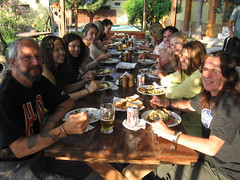
Eli, Matt, and I made the long walk across town to Ephesus, an ancient Greek city and one of the country's best archeological sites. Founded a very long time ago, in 1100 BC, the city was a bustling urban center by about 600 BC, but came into its own during Roman times a few hundred years later. Ephesus is the setting for the Biblical book of Ephesians, which is a letter that Paul wrote which attempts to illuminate the nature and glory of God for the Ephesian people, who Paul considered to be a gang of sexually immoral, drunken deviants. Paul's letter to the Ephesians is now one of the most important, revered, and moving pieces of the Bible. At least according to my quick Google search.
With all of this spiritual business in mind, the three of us gave some thought to the question: How could we learn from Paul's message and enhance our trip to Ephesus? And we naturally came to the conclusion that we should sneak through a hole in the fence to avoid the hefty entry fee. After a half-hour of bushwhacking, with some new scrapes and bruises adorning our legs, we finally made it in.
The ruins were really impressive, and we got there late enough in the day so that they weren't mobbed by tourists, who often pop over to Ephesus on day trips from Greece. The three of us loved climbing around on the extensive city ruins, checking out the spectacular 25,000 seat theatre, and wandering through well-restored Roman houses full of brilliant mosaics. My favorite part was taking inappropriate pictures of Eli at the old Roman toilets, who decided to give the facilities a proper test. Yes, his pants are really down:
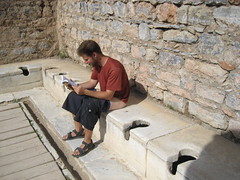
Here are a couple of more traditional photos of Ephesus:

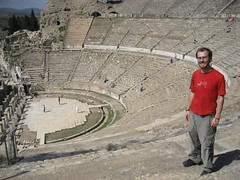
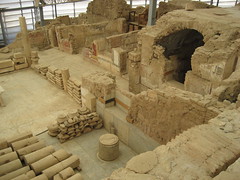
After a visit to the nearby Ephesus Museum back in Selcuk and a few days checking out the ancient sites throughout town, I said goodbye to Emmanuelle and Eli and headed off with Matt on a bus to Pammukale.
The main reason for visiting Pammukale is for it's otherworldly hill of white calcium carbonate deposits, which have formed into strange water-filled terraces over time. The site is also home to another ancient city, Hieropolis, the ruins of which are scattered on the plain above the bubbly white travertines. I had heard mixed reviews about Pammukale from other travelers, but I thought it was amazing. Oddly enough, the place was mobbed with Russian tourists, and I had a good laugh watching scantily-clad girls and their burly Speedo-wearing boyfriends pose seductively in front of the bright snow-like cliffs. Here are some photos, including one of me working on my pose in case I ever decide to audition for The Mickey Mouse Club — "Ryan!"

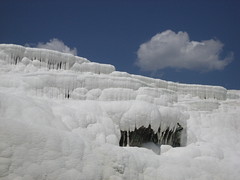
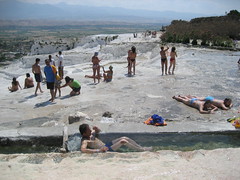
The little village of Pammukale completely clears out at night, so Matt and I went back to the travertines for sunset and had the place almost completely to ourselves, and enjoyed a few beers as we watched the sun fall over the gorgeous terraces:

The next morning, we were back on a bus, this time headed south to Fethiye, a harbor town sandwiched between rolling hills and the Mediterranean Sea. The town's interesting harbor is packed with hundreds of yachts which have sailed in from locations around the world, and many people seemed to be living in their boats right on the docks, having dinner each night on the decks of their ships. I went to Fethiye's bustling market on the town's weekly market day and watched the locals peruse for produce, and I tried my hand at haggling for a nice lunch of fresh fruit.
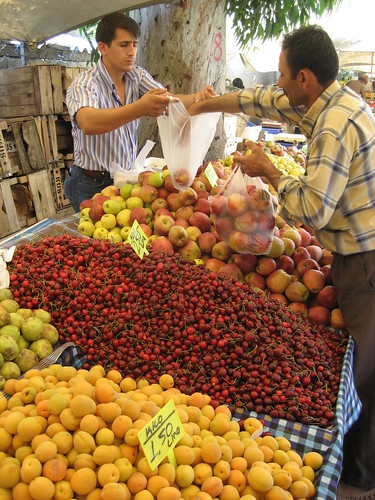
A few miles from Fethiye is a ghost town village called Kaya, which was abandoned after World War I by its former Greek inhabitants. After Attaturk came into power during the Turkish War of Independence, there was a massive transfer of populations as Muslim Greeks moved to Turkey and Ottoman Christians moved over to Greece. The population shift wasn't equal however, and Turkey was left with a lot of towns like Kaya which remained abandoned afterward. The strange ghost town made for a really fascinating day trip, and I spent almost a full day exploring the bizarre and empty place, wandering among more than 2000 houses being slowly eaten by nature, and marveling at Kaya's 17th century churches.
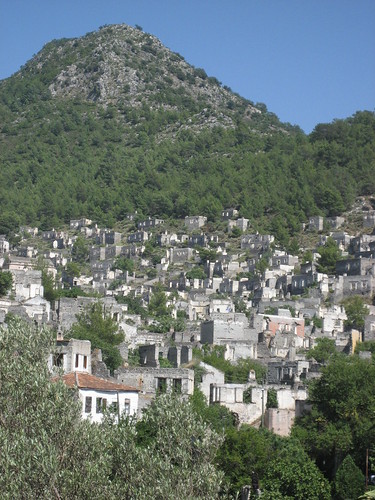
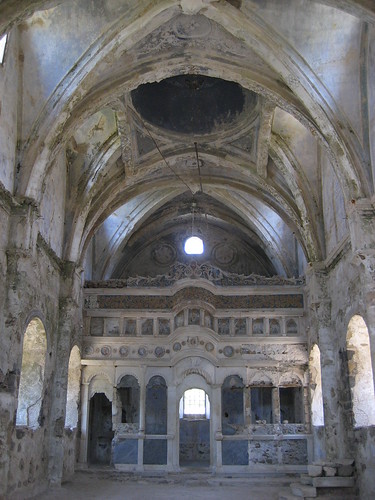
The next day, I decided somewhat randomly to splash out and try something I've never done before: paragliding. So, a group of people from my hostel headed over to the painfully tourist-trodden beach town of Oludeniz, which is sort of like Cancun but for British people, but also serves as the jumping off point for paragliding trips. We piled in a jeep and headed up the mountain on a perilous dirt road, which was more frightening than paragliding itself. We carefully strapped on all of our gear and were each assigned a dude who would be navigating our tandem flight. I was the first in our group to go, and with a short run down a hill, we were off, soaring high into the air above the blue water of the Mediterranean and the beautiful blue lagoon beach of Oludeniz below.

I know what you're thinking: amazing photo. Except I didn't take it — it's the promo photo from the paragliding company. It really was this pretty, however.
I was amazed at how quiet and peaceful it was flying through the air. Someday, I'd love to learn how to paraglide solo so I wouldn't have to have a Turkish man strapped to my back. I encouraged the guy to get crazy and do some tricks and he obliged by doing an insanely fast spiral straight down toward the sunbathers on the beach before swinging back up again toward the sky. The landing was hilarious, because we touched down right in the middle of the beach boardwalk, with overweight leather-skinned Brits scattering to get out of the way. Overall, it was a great experience that I'd definitely repeat.
I left Fethiye and spent the last week in the Cappadoccia region, which is full of truly unbelievable scenery of cave houses carved into naturally occuring rock spires. I wanted to get completely caught up on the blog today, but Turkey's internet is a real piece of work, and it has been a rascal even getting this much completed.
I am in the very Middle Eastern city of Salinurfa now, and plan to spend the next few weeks looping through Eastern Turkey, the much more off-the-beaten-track part of the country. After that, I'm back to Istanbul to meet up with my elementary school friend Matt Coyle who will join me for a month or so of travel in Eastern Europe. Did that make it sound like he's currently in elementary school? Because he's not. That would be awkward.
Thanks for reading,
Ryan!
